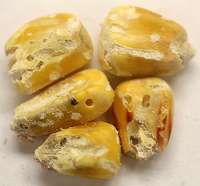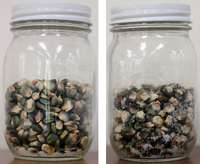
Figure 11. Maize seeds damaged by lesser grain borer weevils (Rhyzopertha dominica). Source: Tim Motis
Spoilage of stored grain is a major obstacle for smallholder farmers around the world (Figure 11). FAO (2022) reported cereal and pulse losses in storage of up to 60% (maize in Uganda), and 50% (cowpea in Zimbabwe). This article leans on the expertise of Dr. Floyd Dowell (an Agricultural Engineer retired from USDA Center for Grain and Animal Health Research) and highlights some of the options covered in previous ECHO publications for grain storage in low-resource settings. Preventing pest and moisture damage to stored commodities takes time, but also saves labor and reduces risks related to post-harvest losses.
Foundational principles
We will use the term grain to refer to seeds that are harvested dry, whether they are from cereal or pulse (dry beans) crops. Before deciding on a storage method, consider a few principles for mitigating grain damage in storage.
Store it dry and cool

Figure 12. Salt jars with subsamples of maize seed; salt at bottom of jar indicates dry seed (left) and salt sticking to glass jar indicates wet seed (right). Source: Tim Motis
Putting grain into storage before it is sufficiently dry leads to mold that can cause spoilage and the production of toxins that can affect humans and animals. Grain can be allowed to dry naturally in the field before harvest, as well as by exposing newly harvested grain to air movement in sun or shade. 4If you plan to mill grain after storage, do not over-dry the seed as this can cause cracking during the milling process. You can also use simple tests, such as the jar test (Figure 12; Reader and Motis, 2017) to determine if grain is dry enough for storage.
Once grain is placed in storage, it needs to be kept dry. Safe moisture content of grain in storage varies with temperature of the air surrounding the grain. Higher temperatures require lower moisture contents. Seed moisture content will reach equilibrium (stabilize) based on grain type and the temperature of the surrounding air (Table 2).
| Common Name | Scientific Name | Equilibrium Moisture Content (%) |
|---|---|---|
| Maize/Corn | Zea mays | 13.5 |
| Sorghum | Sorghum bicolor | 13.5 |
| Rice | Oryza sativa | 15.0 |
| Millet | Pennisetum glaucum | 16.0 |
| Wheat | Triticum spp. | 13.5 |
| Common beans | Phaseolus vulgaris | 15.0 |
| Cowpea | Vigna unguiculata | 15.0 |

Figure 13. Cistern for storing seeds placed in the corner of an enclosure. Source: Stacy Swartz
Store grain and pulses in a cool, dry location off the ground (Figure 13). Keep stored grain from getting wet by keeping them indoors, creating protective structures, or using impermeable material to cover them.
Store it clean

Figure 14. Cowpea bruchid (Callasobruchus maculatus) eggs (left) and adults (right). On the cowpea seed, you can also see a hole where one of the larva emerged. Source: Tim Motis
Thoroughly winnow grains and pulses before storage so that they are free of debris which can host pests and diseases and takes up storage space. Winnowing grain helps remove high-moisture debris that can contribute to grain spoilage. Removal of the debris improves air flow through grain to aid the drying process. Remove damaged seed especially if insect eggs are on the outside of the seed (Figure 14). Unless you are working on a small seed bank level, you will not have time to inspect every seed. Instead, take a sample of 20-50 seeds randomly during your threshing or storing process and inspect each sample thoroughly. If you notice more damage, pest presence, or eggs, slow down and separate those seeds to either clean more thoroughly or consume soon.
Storage options
There certainly is no best storage method for all grain under all conditions and for all insects. Various factors influence what option may be appropriate for your specific needs. For a detailed list and explanation of factors, see ECHO Best Practice Note 5: Seed Storage in the Tropics. Storage methods are specific to the crop, local climate, local pests, length of storage time, and quantity to be stored. Practices for minimizing damage and spoilage of stored grain are hermetic sealing, use of synthetic pesticides or pesticide products, natural pesticide products, reduced temperature storage, and modified atmosphere storage.
Hermetic sealing
Hermetic sealing involves restricting air transfer between the inside and outside of a container overviewed by Motis (2022) in EDN 146. Each time the container is opened, oxygen is re-introduced so this method is not convenient for seed banks distributing seed but has applications for grains and pulses that are stored before consumption or later sale. Results of an ECHO trial indicated a benefit, in terms of reduced maize weevil (Sitophilus zeamais) damage, of filling sealed containers completely full to displace as much oxygen as possible in the container (Dareus, 2021). Hermetic sealing requires that seed be dry before storage to prevent spoilage. In the “Echoes From our Network” article in this issue of EDN, Clint Bower shares his experiences with hermetic sealing in Haiti.

Figure 15. Tubeless bicycle vacuum sealer made from PVC. Source: ECHO Asia Staff
Vacuum sealing is an effective control method for sealable containers. Motis (2019) summarizes this in ECHO Technical Note #93. ECHO Asia regularly vacuum seals large containers of seeds with an improved bicycle vacuum sealer (Figure 15).
Synthetic pesticides or treated products
Synthetic pesticides and pesticide-treated products can control pests in stored commodities. Synthetic pesticides come in gaseous, granular, liquid, and powdered forms. 5 Dowell and Dowell (2017) stored grain in bags made of bed nets treated with deltamethrin (a mosquito- controlling agent) as well as containers with all openings covered with the commercially treated bed nets. After one month of storage, both methods of storing grain using commercially treated bed nets effectively prevented lesser grain borers from entering the stored grain.
Proper handling, use, and disposal of pesticides is important. If you are using pesticides, whether natural or synthetic, always follow safety instructions printed on the label. If there are no safety instructions, research instructions using as many names of the product as you are aware of including local names, active ingredients, and brand names.
Natural pesticides
Naturally occurring pesticide options include ash, neem (Azadirachta indica), diatomaceous earth, crude oils, fish bean (Tephrosia vogelli), and many more. Take the time to ask about locally practiced natural pesticide options for treating grain before storage. Try these options on a small scale to test their effectiveness. Remember that natural pesticides may still have toxic properties, such as fish bean, and therefore need to be handled, applied, and disposed of carefully. Most natural pest control treatments have variable effectiveness.
Mechanical disturbance
Seed mixing involves moving seeds in their relative position to one another on a regular basis. This disruption of seed also disrupts the pest’s life cycle. Rau et al. (2021) achieved 100% reduction of maize weevil (Sitophilus zeamais) after 40 and 80 days with mixing occurring every 12 hours in treatment containers compared to a 28% reduction in control containers after 80 days. The frequency and intensity of mixing required for specific pests is an area for future research.
Reduced temperature storage
Decreasing temperature of stored grains reduces pest and disease activity and slows seed respiration (use of oxygen). There is a range of technologies that can be used for reducing temperature or temperature fluctuations in storage, including the simple practice of opening the seed container when temperatures are cooler (e.g., at night). Kiefer et al. (2020) share detailed steps of how to make earthbag structures with local materials. Cooling devices such as commercial coolers or air conditioners attach to a CoolBot® for use in seed banks but this technology also has applications for high-value grains. Price (2016) explains methods and costs for constructing a cold room at ECHO Asia’s office in ECHO Asia Note 27.
Modified atmosphere storage
Modifying the available oxygen in stored grains restricts pest and disease activity. ECHO has experimented with the replacement/displacement of oxygen —in storage containers— with carbon dioxide and biogas, but effects on different species and potential risks are unknown. Motis (2020) summarizes ECHO’s methodology and observations with modified atmosphere storage of seeds in EDN 146. On a large scale, though, these options may be less applicable.
| Storage Type | Cost (USD) | Benefits | Tradeoffs | |
|---|---|---|---|---|
| Hermetic storage | Purdue Improved Crop Storage bags | ~4 each | Commercially available Reusable for several years | Can be damaged by rodents and handling |
| Barrels | 10-80 | Commercially available Rodent proof Durable Reusable Secure |
High cost | |
| Glass or plastic containers (with lids) | Readily available | Useful only for small samples | ||
| Metal silos | Can be fabricated by skilled artisans, rodent proof | Difficult to make air-tight, high cost | ||
| GrainPro® hermetic bags | ~4 each | Commercially available | Insects and rodents can penetrate bags Damaged by handling |
|
| Vacuum sealing | Safe Effective |
Requires equipment. More appropriate for small samples | ||
| Synthetic pesticides or treated products | Treated bed nets | Commercially available | Diverts nets from their intended use. Seed must be insect-free before storage Useful only for small quantities. |
|
| Vestergaard (2015) Frandsen treated ZeroFly® bags | ~2.5 | Prevents insects from getting into clean grain Can store large quantities |
High cost for some farmers Access Seed must be insect-free before storage |
|
| Synthetic fumigants and powders | Commercially available Effective Useful for bulk storage |
Subject to counterfeiting High cost Can be toxic to humans if not used correctly |
||
| Natural Pesticides | Ash, neem, and diatomaceous earth | Can be obtained locally Useful for bulk storage |
Results are not consistent Can damage seed |
|
| Mechanical Disturbance | Seed Mixing | Safe Simple |
Requires regular attention Potential breakage of grain |
|
| Reduced Temperature Storage |
Earthbag storage |
Safe Locally available |
||
| Modified Atmosphere Storage | Refrigeration CoolBot® |
Effective | Requires a cooling source High cost |
|
| Using CO2 or other gas(es) to displace/replace oxygen | Local options for CO2 or biogas | Must have a source for gas(es) | ||
| Table content drawn primarily from input by Floyd Dowell | ||||
Conclusion
This article is not exhaustive in sharing the diversity of products or options available for storing grains. If you have additional ideas, sources, or other principles to share, please do so at ECHO Conversations.
References
Dareus, R. 2021. Fill it Full: A Simple Way to Reduce Weevil Damage in Maize Seed Stored in Airtight Containers. ECHO Research Notes 2(5).
Dowell, F.E., and C.N. Dowell. 2017. Reducing grain storage losses in developing countries. Quality Assurance and Safety of Crops & Foods. 09(01):93-100.
FAO. 2011. Grain crop drying, handling, and storage. In: Rural structures in the tropics: design and development.
FAO. Technical Platform on the Measurement and Reduction of Food Loss and Waste. Keywords: Cereals and Pulses, Storage. Accessed December 1, 2022.
Kiefer, C., T. Motis, and E. Toevs. 2020. Earthbag Seed Banks. ECHO Technical Note No. 96.
Kugbei, S., M. Avungana, and W. Hugo. 2018. Seeds Toolkit. Module 2 (Seed processing: principles, equipment, and practice). Food and Agriculture Organization of the United Nations and AfricaSeeds.
Mobolade, A. J., N. Bunindro, D. Sahoo., and Y. Rajashekar. 2019. Traditional methods of food grains preservation and storage in Nigeria and India. Annals of Agricultural Sciences 64:196-205.
Motis, T. 2019. Vacuum-Sealing Options for Storing Seeds. ECHO Technical Note no. 93.
Motis, T. 2020. Low Oxygen Methods for Insect Control in Seeds. ECHO Development Notes no. 14.
Price, Z. 2016. Constructing an Improved Cold Room for Seed Storage. ECHO Asia Notes no. 27.
Rau, T.S., C.J. Bern, T.J. Brumm, R.B. Barnes, D. Bbosa, and D.E. Maier. 2021. Evaluation of stirring to suppress weevils in stored maize. Journal of Stored Products Research. 93.
Reader, S. and T. Motis 2017. Are my seeds dry enough? ECHO Development Notes no. 136.
Vestergaard. 2015. ZeroFly Storage Bag: The first insecticide-incorporated polypropylene storage bag. Zerofly.com
Cite this article as:
Swartz, S., T.N. Motis, and F. Dowell. 2022. Recap of Options for Storing Grain. ECHO Development Notes. no 158.